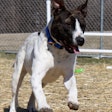The objective of this study, a web-based cross-sectional survey, was to determine the proportion of dog breeders who fed diets meeting the Association of American Feed Control Officials regulations for nutritional adequacy for reproduction and growth, and to investigate factors that influenced feeding practices of breeders.
A self-administered, anonymous, Web-based questionnaire was used to collect information on breeder demographics and feeding practices during three life stages of dogs: adult maintenance for non-pregnant dogs, gestation-lactation and puppy growth. Appropriateness of commercial diets for each life stage was determined by respondent-reported (2,067 total respondents from the US and Canada) nutritional adequacy statements on product labels. Data were also collected regarding breeder criteria for diet selection and sources of nutrition information. A substantial number of breeders reported feeding commercial diets not intended for that life stage during gestation-lactation and puppy growth. Additionally, approximately one-seventh of breeders reported feeding home-prepared diets for one or more life stage(s). Unsubstantiated health and marketing information influenced diet selection of many breeders. Veterinarians, although generally viewed as a trusted source of nutrition information, were consulted by only 823 of 1,669 breeders and were viewed less favorably by breeders feeding home-prepared diets, compared with the opinion of breeders feeding commercial diets.
Veterinarians should consider taking a more proactive role in directing dog breeders and other pet owners toward scientifically substantiated sources of diet information, and in explaining the importance of current nutritional standards for reproduction and early development of dogs.
Source: Kevin M. Connolly, PhD, et al., 2014. Feeding practices of dog breeders in the United States and Canada. JAVMA online, September 2014. doi: 10.2460/javma.245.6.669.


















